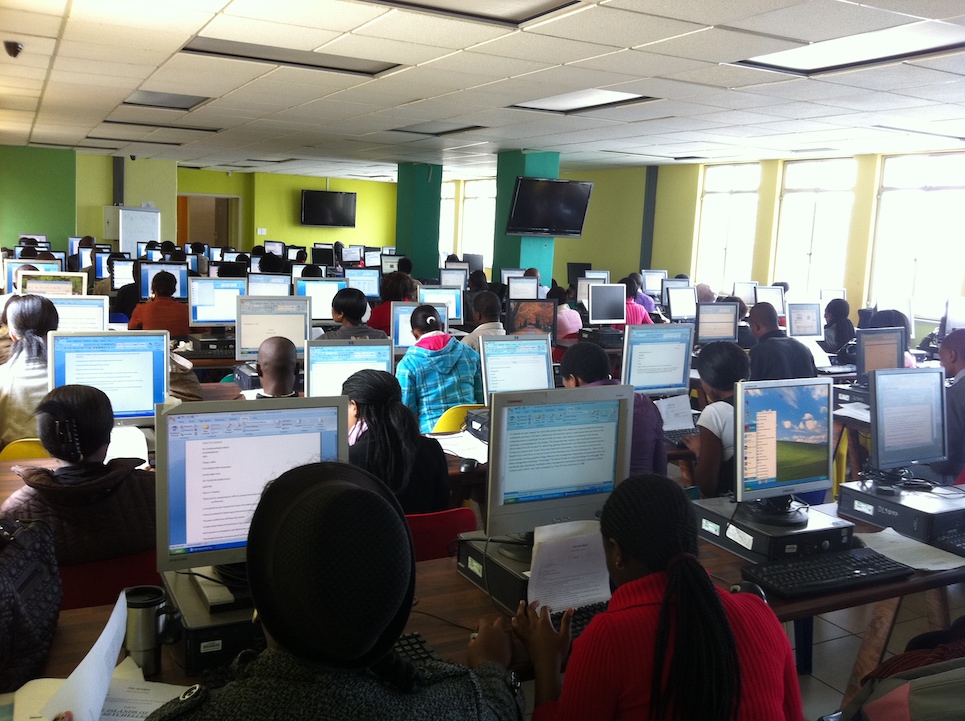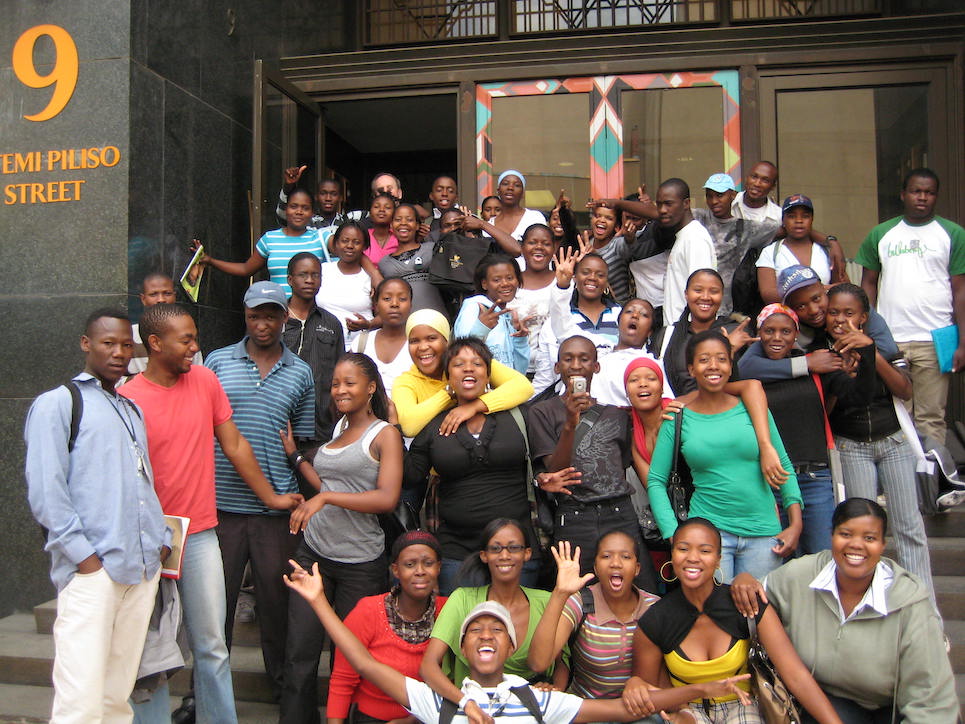
How do you teach a human to be human?
This might sound like a trick question, but it’s a question that Gabriella Geffen has to deal with every day. “Gabi” is a business development expert at the Maharishi Institute and is also a member of the National Task Team responsible for developing Entrepreneurship and Social Entrepreneurship in South Africa.
The world has changed dramatically over the course of the past few decades, and many people are coming face-to-face with a harsh truth: humans will never be better at being robots than robots themselves.
This has dramatically changed the global employment market, and in places like South Africa, it has contributed to massive, systemic unemployment. Some 27 percent of South Africans are unemployed. Youth, meanwhile, face an unemployment rate in excess of 50 percent.
Gabi notes that so many are unemployed even as over a million jobs in South Africa remain unfilled.
Employers want employees and South Africans want jobs.

However, there is a disconnect between the skills and education that employers need, and the skills and education that many South African youth possess. Even those bright South African students that succeed in the face of abject poverty and failing public education systems often find the doors shut when it comes time to acquire an advanced degree.
Many South African public universities have acceptance rates on par with Ivy League universities. Meanwhile, yearly tuition comes in at about $2,000, an insurmountable sum for many of South Africa’s impoverished.
Maharishi Institute founder Taddy Blecher, featured in issue 12 of Change Creator Magazine, realized this after helping impoverished high school students learn meditation techniques that helped them perform better in school. Many students deserving of an opportunity to attend college were simply denied the chance.
How do you break the cycle of poverty?
In a world that is increasingly dependent on college education and people skills, a lack of access to higher education can all but ensure the perpetuity of poverty. So how does one break that cycle?
How do you provide students with an education that will equip them with the skills they need to succeed in the modern world? How do you ensure accessibility, especially for those who are impoverished and disadvantaged?
Gabi and the other staff at the Maharishi Institute grapple with this challenge every day. And the solutions they have come up with may ultimately revolutionize the modern higher education system, both helping teach people to be people in a modern world, and ensuring access for all.
Finding Sustainability to Increase Accessibility
The Maharishi Institute started out with the same ambitions as many other university programs targeting impoverished communities: simply be free. However, as Blecher and other early-day Institute employees found out, there’s no such thing as free. The money always has to come from somewhere. Donations are great, but they are hard to sustain.
The Maharishi Institute shifted towards a pay-it-forward model.
Students would pay fees, but these fees are more affordable than the public universities in South Africa and students are given access to loans. The Institute started with a no-fee model but found itself too dependent on the whims of the donors. However, by having students contribute, the university can better sustain itself. All tuition fees paid go towards ensuring opportunities for future students.
Another challenge would help the Maharishi Institute become even more sustainable, and could pave the way for a tuition-free future. Institute leaders soon learned that many employers didn’t want just a degree, they also wanted experience. Students in South Africa faced the same conundrum students in other countries have to deal with: Employers demand experience but students can’t acquire that experience because no one will hire them.
The Maharishi Institute provides business education to thousands of students. These students have business skills, so why not use them? The Maharishi Institute has been building out businesses, essentially hiring its own students and then paying them.

Currently, the Institute is focused on building up Invincible Outsourcing, which aims to become a first-rate outsourcing and call centre business in South Africa. Enrolled students can not only pay for their tuition but also earn a stipend to pay for daily living. This makes education not only affordable but sustainable for poor students.
For impoverished students, the ability to work through school and to be paid for that work also helps lower the often overlooked opportunity costs. When your family is barely scraping by, heading off to college to increase your future wages can seem almost selfish. After all, your family members have to eat today, not tomorrow. Shouldn’t you be out trying to earn an income now rather than in the future?
For many impoverished South African youth, this is the reality they face. The Maharishi Institute is providing a solution. Attend university and help the Institute build up businesses along the way. These business aspirations help students pay for their life in the moment. On-the-job training and work experience, meanwhile, helps students further build up their resumes, establish networks, and prove their mettle.
Some students also go on to work at partner companies, such as Accenture. The Maharishi Institute’s leadership has found that while many companies want to invest in education, few know how to actually do so, and often the results are, at best, scattershot. For companies, rather than funding a school or classroom, hiring students, paying them a wage, and then providing on-the-job training can be an effective way to contribute to the student’s success while pursuing their own business aims along the way.
Regardless of where they work, students are given an invaluable opportunity to break the cycle of no experience. With actual job experience in hand, Maharishi graduates are among the most competitive in the market. Indeed, nearly every graduate has secured a skilled job, and collectively, Maharishi’s 17,000 graduates earn over 1 billion rand per year! To put that into perspective, the Institute itself runs on just 24 million rand per year, highlighting the tremendous return on investment.
If Our Deepest Drives Shape the World – How do we Reshape it? | Gabriella Geffen | TEDxCapeTown
Meditation Is Another Key Ingredient to Success
You might be wondering what Maharishi means. This term actually refers to Maharishi Mahesh Yogi, a meditation guru who founded Transcendental Meditation, which in turn is another key element of the Institute’s success. Early on, Blecher and other staff members realized that many students were coming from backgrounds that were so traumatic, that they struggled to focus in class. In fact, many students were suffering from various forms of post-traumatic stress disorder.
Despite his doctorate and sterling academic resume, Blecher himself was far from a model student when he began is actuary studies. In fact, he struggled in many classes and was at risk of failing. Then he discovered Transcendental Meditation, a scientifically proven form of meditation to greatly enhance concentration, clarity, creativity and learning and retention rates. For Blecher, Transcendental Meditation would be life-changing, and so it was incorporated directly into the Maharishi Institute’s curriculum.

Of course, just because meditation worked for Blecher, that doesn’t guarantee that it will work for other students. A renowned public university in Johannesburg decided to test the effectiveness of meditation in reducing stress among college students. The University took its own first-year students and the Institute’s first-year students and then measured their stress levels. Unsurprisingly, many students from both organizations were suffering from high levels of stress.
At the end of the year, an independent psychological study measured stress levels once again. The results? Students at the university reported increased stress levels. This should come as no surprise. After all, the burdens and expectations of a university can be overwhelming. However, when the University remeasured students at the Maharishi Institute, they found that stress levels had dropped substantially. In fact, many students were asymptomatic, seemingly cured of their PTSD symptoms and high-stress levels.
For the Maharishi Institute, meditation is as important an element for teaching humans to be human as formal education. While the Institute’s bread and butter is online, remote education, Gabi stresses that providing students with an opportunity to make professional connections is vital for helping them further their career.
Digital Delivery, Human Focus
Technology is at the heart of the Maharishi Institute’s long-term aims. Yes, many of the students are taught technology-related skills, but it goes much deeper than that. The Institute’s long-term aim is to continue to reduce costs. While most Universities around the world are constantly increasing fees, the Institute is constantly searching for ways to reduce them. With technology and the increased success of its business-side operations, the Institute hopes to eventually charge students only $500 per year in tuition.
Yet as Gabi points out, Universities aren’t just about imparting academic knowledge but also teaching human skills and encouraging the growth of human networks. What makes Harvard Harvard and Oxford Oxford isn’t just the world-class faculty. It’s also the networking opportunities and chances to build lasting relationships. The Maharishi Institute combines distance learning with site learning and on-the-job training. By doing so, Maharishi students can build up human networks and relationships in a way that many online students can’t.
Ultimately, the proof is in the pudding. While many South African universities have a throughput rate of about 25 percent, meaning only a quarter of students finish their degrees, the Institute’s throughput rate weighs in at 80 percent. This, even as up to 70 percent of students arrive unequipped for a university. A combination of meditation training and foundational education allows the Institute to get students up to speed quickly. Roughly 17,000 students have already been educated, and combined they earn over 1 billion rand per year.
Now, the Maharishi Institute is looking to take the lessons learned and to offer opportunities not just in every province in South Africa, but across the world. The University aims to be on the ground in at least 15 countries in the next five or so years. Besides other African nations, India and non-African countries are being targeted. Currently, the Maharishi Institute is aiming to train 100,000 business leaders who will generate over 1 trillion rand in lifetime earnings.
Along the way, the Maharishi Institute is providing valuable lessons to other social entrepreneurs looking to shake up the education sector. It’s not enough to impart knowledge, you have to teach people to be people. In the modern world, humans can’t compete with robots, but by focusing on human skills, universities can still help students launch successful careers.
For those coming from traumatic backgrounds, that could mean teaching meditation or other methods to increase focus. Further, while technology is a useful tool, educators need to remain conscious of the need to teach people skills and to build social networks.
Key Takeaways:
Maharishi Institute moved beyond free tuition and relying entirely on donors by asking students to pay it forward with tuition fees. By doing so, they built a more sustainable model that will provide more opportunities to future students.
The Maharishi Institute leverages online learning. However, they use site-based learning as well to impart people skills and to help students cultivate personal networks.
Founder Taddy Blecher recognized that students who were coming from such underprivileged backgrounds struggled to focus. Transcendental meditation training, however, has been proven to alleviate stress-related conditions.
Listen to our full exclusive interview with Gabriella Geffen
https://changecreator.com/10-female-heroes-that-changed-the-course-of-history/






